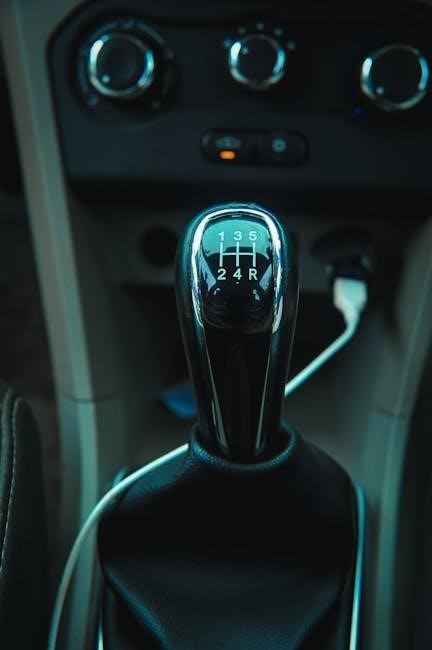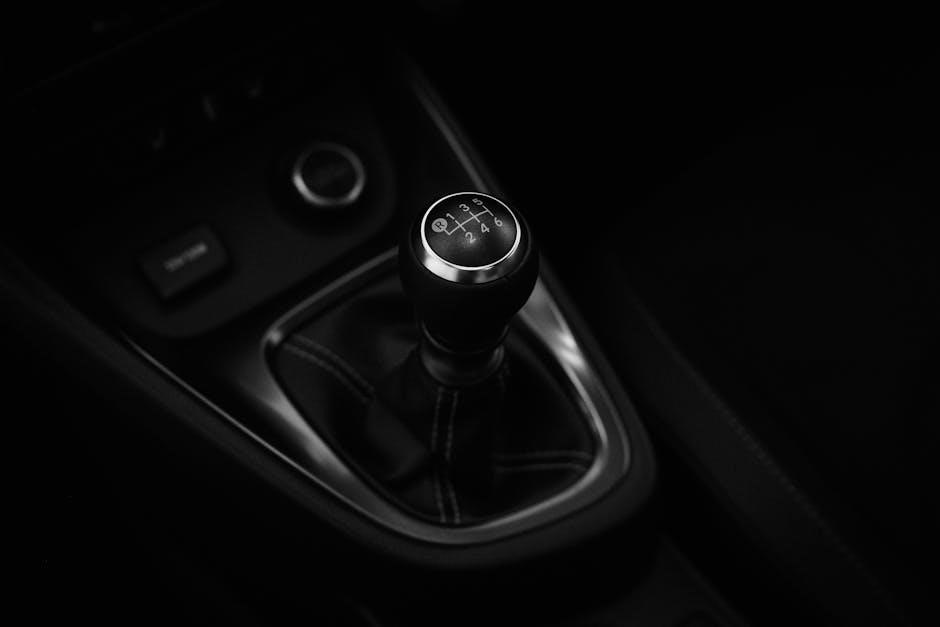The LS engine’s popularity comes down to its reliability‚ power‚ and easy integration. GM made these engines modular‚ meaning they work well with many GM transmissions. This manual explores your transmission options when performing an LS swap‚ from automatics to manuals.

Common GM Transmissions for LS Engines
Understanding the landscape of available GM transmissions is crucial for a successful LS engine swap. While LS engines weren’t introduced until 1997‚ tracing back to earlier transmissions like the 700R4 (introduced in 1982) provides valuable context. The 4L60E stands out as a prevalent choice‚ largely because it was the original automatic transmission paired with many LS engines‚ boasting a reputation for strength and dependability. Its compact size and readily available parts make it a popular option for various swap applications. Dimensionally similar to the older Turbo 350‚ the 4L60E offers a relatively straightforward swap-in solution. For those seeking greater strength and durability‚ the 4L80E presents a robust alternative. While physically larger than the 4L60E‚ the 4L80E is renowned for its ability to handle significantly higher horsepower and torque levels‚ making it suitable for more demanding applications. Both the 4L60E and 4L80E are electronically controlled‚ requiring a compatible controller for proper operation; Later model transmissions‚ particularly those from 2007 onwards (featuring 15 amp; 17 pins)‚ are generally preferred for Gen IV 58x applications‚ although 13-pin transmissions can be adapted with a custom operating system and tune. Keep in mind that transmission specifications can vary between vehicles‚ and knowing whether the engine is internally or externally balanced is vital for selecting the correct flexplate and torque converter. Ultimately‚ the best transmission choice depends on factors like the engine’s power output‚ the vehicle’s intended use‚ and budget considerations. Exploring these common GM transmission options will pave the way for a well-matched and reliable LS swap.

Manual Transmission Options for LS Swaps
When considering a manual transmission for your LS swap‚ several options offer varying degrees of performance and compatibility. The T56‚ particularly the LS-specific T56 Magnum‚ is a popular choice‚ known for its robust construction and smooth shifting. It’s a six-speed transmission that provides excellent gear ratios for both acceleration and fuel efficiency. The T56 requires careful selection of the correct bellhousing‚ clutch‚ and other related components to ensure proper fitment and operation with the LS engine. Another option is the Aisin AR-5‚ a five-speed transmission found in vehicles like the Colorado‚ Canyon‚ Solstice‚ and Sky. While not as inherently strong as the T56‚ the AR-5 can be a cost-effective solution for less demanding applications‚ especially when paired with an adapter plate. The Nissan CD009 is another manual transmission being considered for LS swaps‚ needing some adapters. Selecting the right manual transmission involves assessing your power goals‚ intended use‚ and budget. Gear ratios play a crucial role‚ as they directly impact acceleration‚ top speed‚ and overall driving experience. You’ll need to determine if the gearing is within your range of needs. Additionally‚ consider the availability of aftermarket support‚ including bellhousings‚ clutches‚ and shifters‚ to facilitate the swap process. Leave all the head scratching to us‚ as we have your manual transmission bellhousing solution for your LS swap all figured out already. Ensuring proper clutch selection‚ including the correct pilot bearing and release bearing‚ is essential for smooth and reliable operation. Ultimately‚ choosing the right manual transmission involves careful planning and consideration of all relevant factors to achieve the desired performance and driving characteristics.
Considerations for LS Swaps in Older Vehicles
Performing an LS swap in an older vehicle presents unique challenges and requires careful consideration of several factors to ensure a successful and safe conversion. One of the primary concerns is the change in weight distribution and stance that often accompanies an LS swap. The lighter weight of the LS engine compared to older engines can alter the vehicle’s handling characteristics‚ potentially affecting its stability and braking performance. Therefore‚ upgrading the suspension system is crucial to compensate for these changes and maintain optimal handling. This may involve installing new springs‚ shocks‚ and sway bars to improve ride quality and cornering ability. The power output of the LS engine necessitates careful consideration of the existing drivetrain components. Older vehicles may not have the robust transmissions‚ driveshafts‚ and axles required to handle the increased torque and horsepower. Upgrading these components is essential to prevent premature failure and ensure reliable performance. Custom-built driveshafts may be necessary to accommodate the specific transmission and chassis combination. Furthermore‚ adapting the LS engine to the older vehicle’s electrical system requires careful planning and execution. Integrating the engine’s wiring harness with the existing vehicle wiring may involve modifications and the use of aftermarket control systems. Ensuring proper gauge function and compatibility with the vehicle’s instrumentation is also important. When selecting a transmission‚ it might not be what you want in the car or simply doesn’t fit the car‚ or the engine has been bought as a stand-alone. This is a common dilemma when performing an LS swap on an old muscle car‚ with the goal of getting the power‚ driveability‚ and dependability of the engine‚ but retaining the feel and fit of a period-correct type of.

Adapting GM Transmissions to LS Engines
Adapting GM transmissions to LS engines is a common practice in the automotive world‚ driven by the LS engine’s popularity and versatility. GM designed these engines to be modular‚ enabling seamless integration with various GM transmissions. This adaptability is a key factor in the widespread adoption of LS swaps across different vehicle platforms. When selecting a transmission for an LS engine‚ compatibility is paramount. Fortunately‚ all LS engines share the standard GM bellhousing bolt pattern‚ ensuring that most GM transmissions will bolt directly to the engine without major modifications. The dowel pins are positioned correctly‚ and typically five out of six bolt holes will align‚ simplifying the installation process. For those seeking to retain the classic feel of older vehicles while enjoying the benefits of LS power‚ adapting older GM transmissions is a viable option. Modern electronic transmissions are incredible‚ but many enthusiasts prefer the simplicity and lower cost of two- and three-speed transmissions. Adapting these transmissions to an LS engine requires careful consideration of factors such as torque converter compatibility‚ flexplate selection‚ and transmission control. The three-speed Turbo 350 and four-speed 4L60E‚ for instance‚ share dimensional similarities and a common family tree‚ making them relatively straightforward to adapt to LS engines. Proper adaptation may involve using adapter plates‚ custom-built torque converters‚ and aftermarket controllers to ensure seamless integration and optimal performance. For those seeking a more modern transmission option‚ the 4L60E is a popular choice due to its proven strength‚ reliability‚ and compatibility with a wide range of LS engines. It is a strong and reliable transmission. 2007 and newer transmissions (15 amp; 17 pins) are the ideal transmission to use on 58x Gen IV applications‚ however 13 pin transmissions can be used with a custom operating system and tune. Selecting the appropriate transmission depends on factors such as the engine’s power output‚ the vehicle’s intended use‚ and the desired driving experience.
Essential Transmission Parts for LS Swaps
An LS swap involves more than just the engine and transmission; it requires a collection of essential parts to ensure seamless integration and optimal performance. Upgrading your transmission with top-quality parts designed for LS swaps is crucial for a successful project. These parts facilitate proper fitment‚ functionality‚ and durability‚ allowing you to harness the full potential of your LS engine. Our extensive product range includes paddle shifter kits‚ speedo adapters‚ flexplates‚ and more‚ ensuring you have all the essential components for a successful transmission upgrade. A properly selected flexplate ensures correct alignment and torque transfer between the engine and transmission. Given that the torque converter bolt pattern can differ between LS and older transmissions‚ selecting the correct flexplate is critical for compatibility. Speedo adapters are another essential component‚ particularly when adapting older transmissions to LS engines. These adapters allow the original speedometer to function accurately with the newer transmission’s output. Paddle shifter kits are popular upgrades for automatic transmissions‚ providing enhanced control and a sporty driving experience. These kits typically include paddle shifters‚ wiring harnesses‚ and control modules that integrate seamlessly with the transmission’s electronic control system. Ensuring proper driveshaft length is crucial for a successful LS swap. Custom-built driveshafts tailored to the specific transmission and vehicle dimensions guarantee smooth and vibration-free operation. When working with electronically controlled transmissions‚ such as the 4L60E or 4L80E‚ aftermarket controllers are often necessary to manage shift points and other parameters; These controllers allow fine-tuning of the transmission’s behavior to match the engine’s characteristics and the driver’s preferences. Transmission mounts are another critical component‚ ensuring secure and stable mounting of the transmission in the vehicle chassis. Upgrading to heavy-duty transmission mounts can improve durability and reduce vibrations. By carefully selecting and installing these essential transmission parts‚ you can enhance the performance‚ reliability‚ and overall driving experience of your LS-swapped vehicle. Whether youre working with a 6L80/90‚ 8L90‚ or other transmission types…
Flexplate and Torque Converter Compatibility

When performing an LS swap‚ ensuring compatibility between the flexplate and torque converter is crucial for proper drivetrain function. The flexplate acts as an adapter between the engine’s crankshaft and the torque converter‚ transmitting rotational force from the engine to the transmission. However‚ the torque converter bolt patterns and pilot lengths can vary between different GM transmissions and LS engine generations‚ leading to potential compatibility issues. One common issue arises from the different torque converter bolt patterns used on LS transmissions compared to older GM transmissions. Fortunately‚ the solution to this problem is a simple one. You can have a converter custom-built for the application‚ or you can change the flexplate to one that has the correct bolt pattern and accommodates the different pilot length of the older type torque converter. Selecting the appropriate flexplate is essential to ensure proper engagement and prevent damage to the transmission. Regardless of the size‚ its also crucial to know whether the engine is internally or externally balanced‚ as that will dictate the type of flexplate required. An incorrectly matched flexplate can lead to severe vibrations and potential engine damage. In cases where a custom torque converter is not feasible‚ using an adapter flexplate is a viable alternative. These flexplates are designed to bridge the gap between different bolt patterns and pilot lengths‚ allowing the use of a readily available torque converter with the LS engine. It is also critical to ensure the torque converter is properly seated in the transmission before installation. Failure to do so can result in damage to the transmission pump and other internal components. Furthermore‚ the flexplate should be inspected for any signs of damage or wear before installation. Cracks or distortions can compromise its structural integrity and lead to failure under load. By carefully considering these factors and selecting the appropriate flexplate and torque converter combination‚ you can ensure a reliable and trouble-free LS swap. Remember to consult with a qualified transmission specialist or LS swap expert to determine the best solution for your specific application. For LS swaps using a four- or speed-transmission‚ PN 425319504‚ includes a billet steel bellhousing‚ a flywheel‚ clutch‚ the correct pilot bearing‚ release bearing‚ and more.